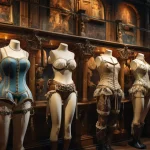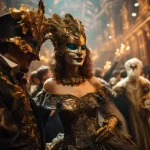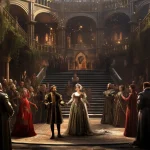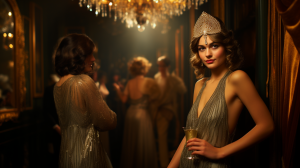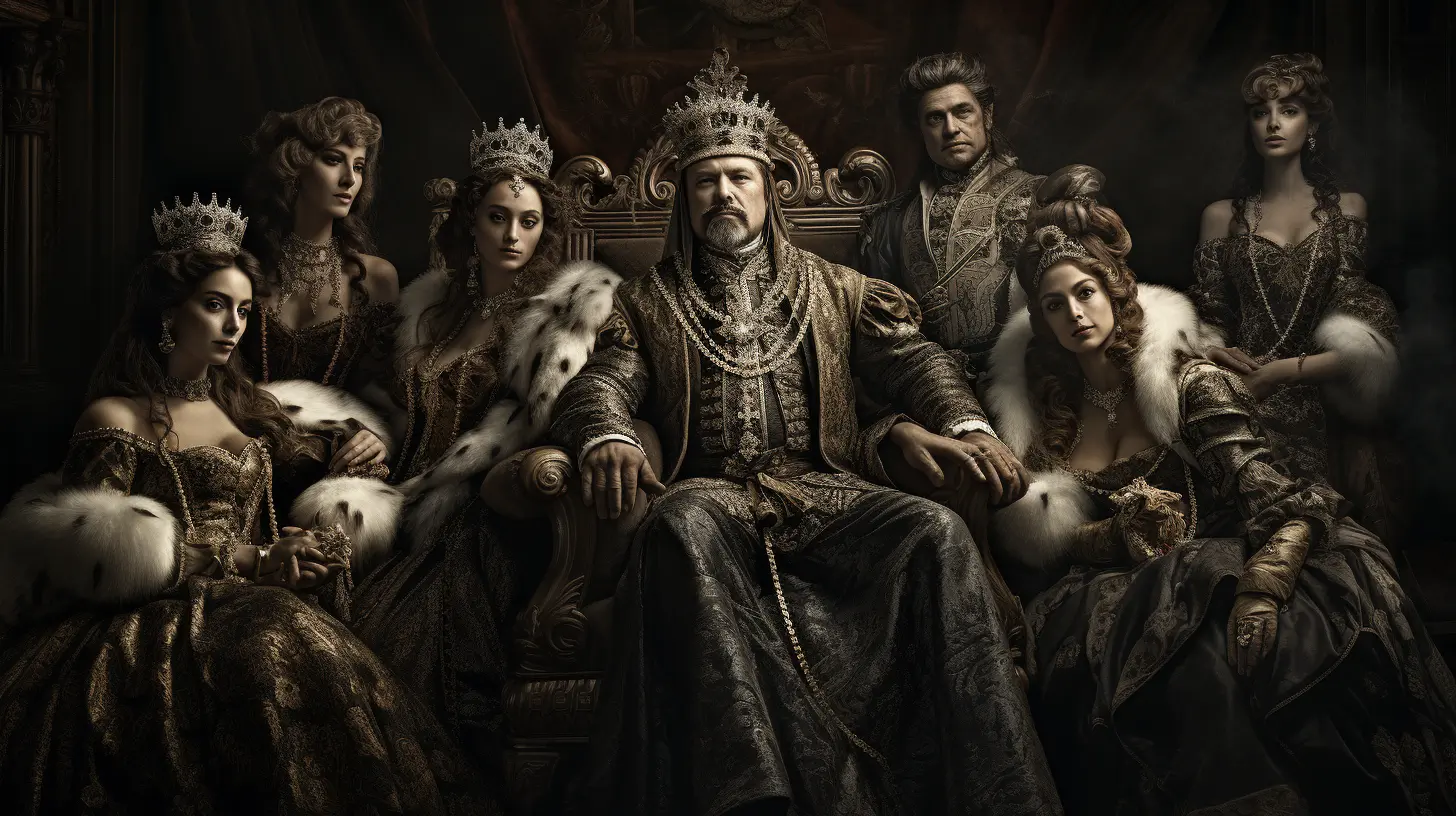
👑 Medieval Majesty: Unraveling the Clothing of Kings and Queens 👑
Ladies and gentlemen, fashion enthusiasts, and fellow time-travelers, I bid you a grand welcome to a realm where history unfolds in threads of opulence and regal splendor. Close your eyes for a moment, and let your imagination transport you to a bygone era, where kings and queens reigned supreme, and every stitch of clothing whispered tales of power and prestige. Medieval royal fashion, the focus of our splendid journey, beckons you to uncover the sumptuous attire that adorned the monarchs of yore.
In this captivating odyssey, we shall traverse the annals of time, unwrapping the layers of history to reveal the resplendent garments worn by kings and queens. It’s a journey that promises to immerse you in the richness of medieval monarchy, where every robe, crown, and jewel tells a story of grandeur and aspiration.
Picture, if you will, the halls of medieval castles resounding with the rustle of silks and the clinking of jewels as royalty graced their courts. The flicker of candlelight casting an enchanting glow on intricately embroidered gowns and ornate crowns. Medieval royal fashion is a tapestry woven with exquisite fabrics, intricate designs, and a touch of mystique. It’s a testament to an era when clothing was more than just attire; it was a symbol of authority, a manifestation of divine right, and a canvas for artistic expression.
Now, as we embark on this journey together, I invite you to delve deeper into the nuances of medieval royal fashion. Prepare to be enchanted by the regal robes worn by kings and the resplendent gowns adorning queens. Marvel at the craftsmanship that turned mere fabrics into works of art and be intrigued by the cultural significance hidden within every stitch and fold.
So, without further ado, let us step into the grandeur of the medieval era, where kings and queens ruled with both might and majesty. As your guide on this fascinating expedition, I promise you a voyage through time like no other, one that will leave you in awe of the Medieval Majesty.
The Medieval Era: A Royal Backdrop
In our journey through the corridors of medieval majesty, it is paramount that we first set the stage with a comprehensive understanding of the era that gave birth to the grandeur of royal fashion. The medieval period, characterized by its distinct social hierarchy, political intrigue, and cultural fervor, laid the foundation for the regal attire that would come to define kings and queens.
Medieval Society and Hierarchy
At the heart of the medieval era was a society marked by stark divisions. Monarchs sat atop the pyramid of power, with divine right legitimizing their rule. Below them, a complex web of nobility, clergy, and commoners formed the social fabric. Understanding this hierarchy is essential to grasp the significance of royal fashion.
Role of Monarchs
Kings and queens during this epoch were more than mere figureheads; they were central to governance, justice, and the spiritual life of their realms. Their attire was not just a matter of personal preference but a statement of their divine mandate and authority.
The Power of Symbolism in Clothing
Now, let us turn our gaze toward the clothing of kings and queens. In a society where symbols and allegory held immense sway, every aspect of their attire carried meaning. The colors they chose, the materials they wore, and the motifs that adorned their garments conveyed messages about their rule, lineage, and aspirations.
Robes of Authority
For kings, their robes were more than garments; they were regal insignia. Robes often featured rich velvets, brocades, and furs, reflecting their exalted status. Crimson and purple robes, embellished with gold, were favored, symbolizing royalty and power. (Placeholder for Image: A richly embroidered royal robe, resplendent in crimson and gold, symbolizing regal authority.)
Crowning Glory
In addition to robes, crowns held a special place in royal fashion. Each crown design was unique, with intricate details representing the monarch’s lineage and dominion. Crowns adorned with precious gemstones and enameled designs added to their splendor. 
(Image: A magnificent crown, studded with gems and pearls, as a symbol of royal sovereignty.)
As we immerse ourselves in the medieval world, we begin to see that the clothing of kings and queens was more than a matter of personal style; it was a reflection of their divine right and the intricate web of symbolism that defined their rule.
Kings’ Attire: Regal Robes and Crowned Glory
As we step further into the world of medieval royal fashion, it’s time to turn our attention to the attire that adorned kings. These garments were not merely fabrics; they were manifestations of power, authority, and a reflection of the era’s opulence.
King’s Robes: A Cloak of Authority
The king’s robes were a symbol of regal authority and divine right. Crafted with meticulous care, these garments embodied the essence of power.
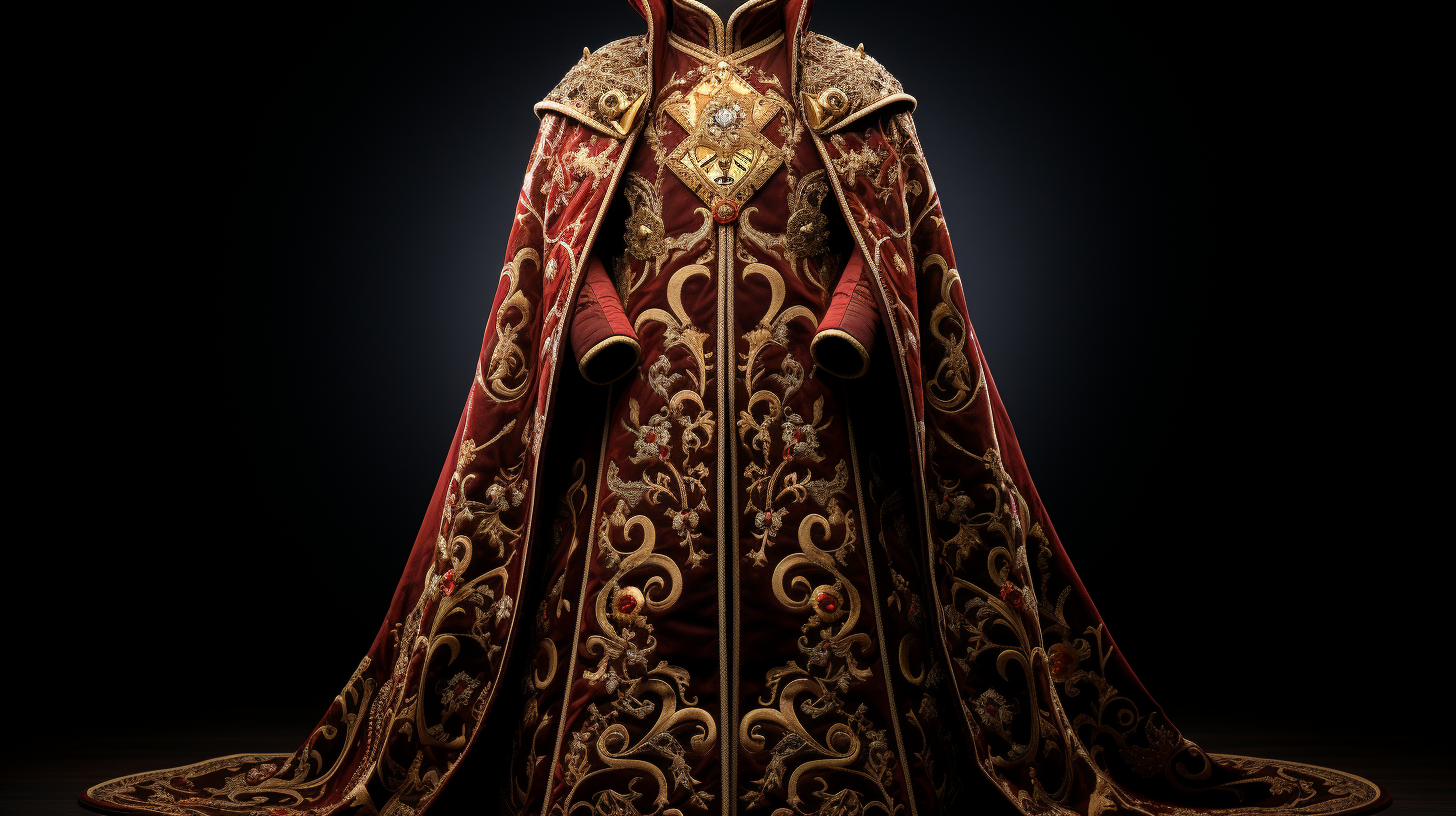
Image: a magnificent royal robe, meticulously embroidered with gold
threads and adorned with regal symbols, epitomizing kingly authority.
- Materials Fit for a Monarch: Kings’ robes were often tailored from the finest fabrics, including silk, velvet, and brocade. These materials were not just luxurious; they were statements of wealth and influence.
- Colors and Symbolism: The choice of colors was of paramount importance. Rich, deep hues such as crimson, sapphire, and emerald symbolized royal majesty. Gold accents and intricate embroidery further enhanced the symbolism of power.
Royal Crowns and Headdresses: The Sign of Sovereignty
No royal ensemble was complete without a crown. These intricate headpieces were not merely ornamental but bore immense significance.
(Placeholder for Image: A regal crown, bedecked with precious gemstones and intricate filigree work, representing the pinnacle of royal sovereignty.)
- Unique Designs: Each crown was a unique work of art, tailored to the preferences and lineage of the monarch. Gemstones, pearls, and enamel work adorned these crowns, signifying dominion and nobility.
- Symbolism in Crowns: The design of the crown often incorporated symbols, such as fleurs-de-lis or crosses, reflecting the king’s connection to divinity and the Church.
As we explore the attire of kings, we begin to unravel the layers of symbolism and grandeur that defined their role in medieval society. These garments were not just a matter of personal style; they were the very fabric of kingship itself.
Queens’ Attire: Regal Gowns and Dazzling Adornments
Now, as we turn our gaze to the women who shared the thrones of medieval monarchs, we enter a realm of unparalleled elegance and grace. The queens of this era, often wielding considerable influence behind the scenes, were not only symbols of beauty but also of power and diplomacy.
Queen’s Gowns: A Symphony of Opulence
The gowns worn by medieval queens were nothing short of masterpieces. Crafted by skilled artisans, they were the epitome of extravagance and refinement.

(An exquisite queen’s gown, adorned with intricate lacework, pearls, and precious gems, exemplifying the pinnacle of regal elegance.)
- Sumptuous Fabrics: Queens’ gowns were typically tailored from the most luxurious fabrics available, including silk, satin, and damask. These materials draped gracefully, enhancing the queen’s regal presence.
- Elegant Designs: The designs of these gowns were characterized by elaborate embroidery, lacework, and rich embellishments. They often featured long, flowing sleeves and intricate bodices, reflecting the fashion aesthetics of the time.
Jewelry and Accessories: Enhancing Royal Beauty
To complement their resplendent gowns, medieval queens adorned themselves with exquisite jewelry and accessories that added to their allure and prestige.
(Placeholder for Image: A queen’s ornate jewelry collection, featuring necklaces, earrings, and brooches, each piece reflecting the queen’s personal style and the opulence of the era.)
- Royal Jewels: Queens wore an array of jewelry, including necklaces, earrings, bracelets, and rings, often studded with precious gemstones like rubies, sapphires, and pearls. These jewels were a testament to their wealth and status.
- Royal Regalia: Some queens even had their crowns or tiaras, symbolizing their role as consorts to the king. These regal headpieces were adorned with gems and intricate metalwork.
As we delve into the wardrobe of medieval queens, we discover a world of elegance and extravagance. Their attire, from sumptuous gowns to exquisite jewelry, was not merely a reflection of their personal taste but a statement of their position as powerful consorts and diplomats.
Royal Fashion Evolution: A Tapestry of Time
Our exploration of medieval royal fashion would be incomplete without tracing the fascinating journey of how regal attire evolved over the centuries. Like the changing seasons, fashion trends in the royal court shifted, reflecting not only the tastes of the monarchs but also the societal influences of their times.
Changes Over Time: Evolution of Style
As we navigate the annals of history, it becomes evident that medieval royal fashion was not static but a dynamic force that evolved with the passage of time.
- Early Medieval Era: In the early medieval period, attire was often characterized by simplicity. The focus was on functionality, and clothing was designed for comfort and practicality. Gowns and robes were typically long and loose-fitting, and materials were limited.
- High Medieval Era: The High Middle Ages saw a transformation in fashion. Kings and queens began to embrace opulent fabrics, vibrant colors, and intricate embellishments. The use of jewelry and elaborate headpieces became more common.
- Late Medieval Era: As we approach the late medieval period, we witness a fusion of Gothic and Renaissance influences. Gowns became more structured, with tight bodices and voluminous skirts. The use of luxurious fabrics and elaborate embroidery reached its zenith.
Influence on Contemporary Fashion: A Timeless Legacy
The allure of medieval royal fashion extends far beyond its time, leaving an indelible mark on contemporary trends. Designers and fashionistas continue to draw inspiration from the opulence and grandeur of the past.
- Runway Reverberations: Runways around the world have witnessed a resurgence of medieval-inspired fashion. Elements such as flowing robes, ornate headpieces, and rich colors have made a comeback, showcasing the timelessness of these designs.
- Modern Interpretations: Contemporary designers infuse medieval aesthetics into their creations, blending historical elegance with modern sensibilities. The influence of royal fashion can be seen in everything from wedding gowns to haute couture.
As we unravel the evolution of royal fashion, it becomes apparent that the echoes of the past continue to resonate in the present. The styles of kings and queens from centuries ago remain an enduring source of inspiration for designers and fashion enthusiasts alike.
The Royal Court: Where Fashion Meets Nobility
Ah, the royal court—a place where power, politics, and fashion converged in a magnificent display of grandeur. In this section, we shall step beyond the monarchs themselves and explore the attire of those who surrounded them, the nobles and courtiers. The court was not just a gathering of individuals; it was a theater of fashion and social hierarchy.
Courtiers’ Attire: Noble Elegance
The nobles and courtiers of the medieval era were not to be outdone in matters of fashion. They too, donned attire that spoke of their status and reflected the opulence of the court.

( An ensemble of noble courtiers, resplendent in lavish fabrics, intricate embroidery, and fashionable headwear, epitomizing the elegance of the medieval court.)
- Exquisite Fabrics: Like the monarchs, nobles favored sumptuous fabrics such as silk, brocade, and damask. Their garments featured fine tailoring, and intricate patterns, and often displayed their family’s crest or emblem.
- Headwear and Accessories: Courtiers adorned themselves with stylish headpieces and accessories. Feathered hats, jeweled belts, and finely crafted shoes completed their ensembles.
Dress Codes and Etiquette: The Art of Courtly Dress
Within the royal court, strict dress codes and etiquettes governed every aspect of attire. Understanding these rules was essential for anyone seeking to navigate the complex social landscape.
- Sumptuary Laws: Medieval society had sumptuary laws that regulated who could wear certain colors, fabrics, or styles. These laws aimed to maintain social hierarchy and prevent ostentatious displays of wealth.
- Hierarchy of Dress: Courtiers were acutely aware of their rank and dressed accordingly. The hierarchy was evident not only in the quality of fabrics but also in the size and opulence of accessories.
As we step into the world of the royal court, we are transported to an era where fashion was a language, and clothing was a statement. The nobles and courtiers played their part in this sartorial drama, adding layers of elegance and splendor to the medieval court.
Cultural Significance: Where Threads Weave Society
As we continue our captivating journey through the annals of medieval royal fashion, we arrive at a pivotal juncture—exploring the cultural significance embedded within these garments. Fashion in the medieval era was not just about aesthetics; it was a mirror reflecting the values, beliefs, and societal changes of the time.
Religious Influence: Divine Threads
Religion held a profound sway over medieval society, and this influence extended to the clothing of monarchs and nobles.
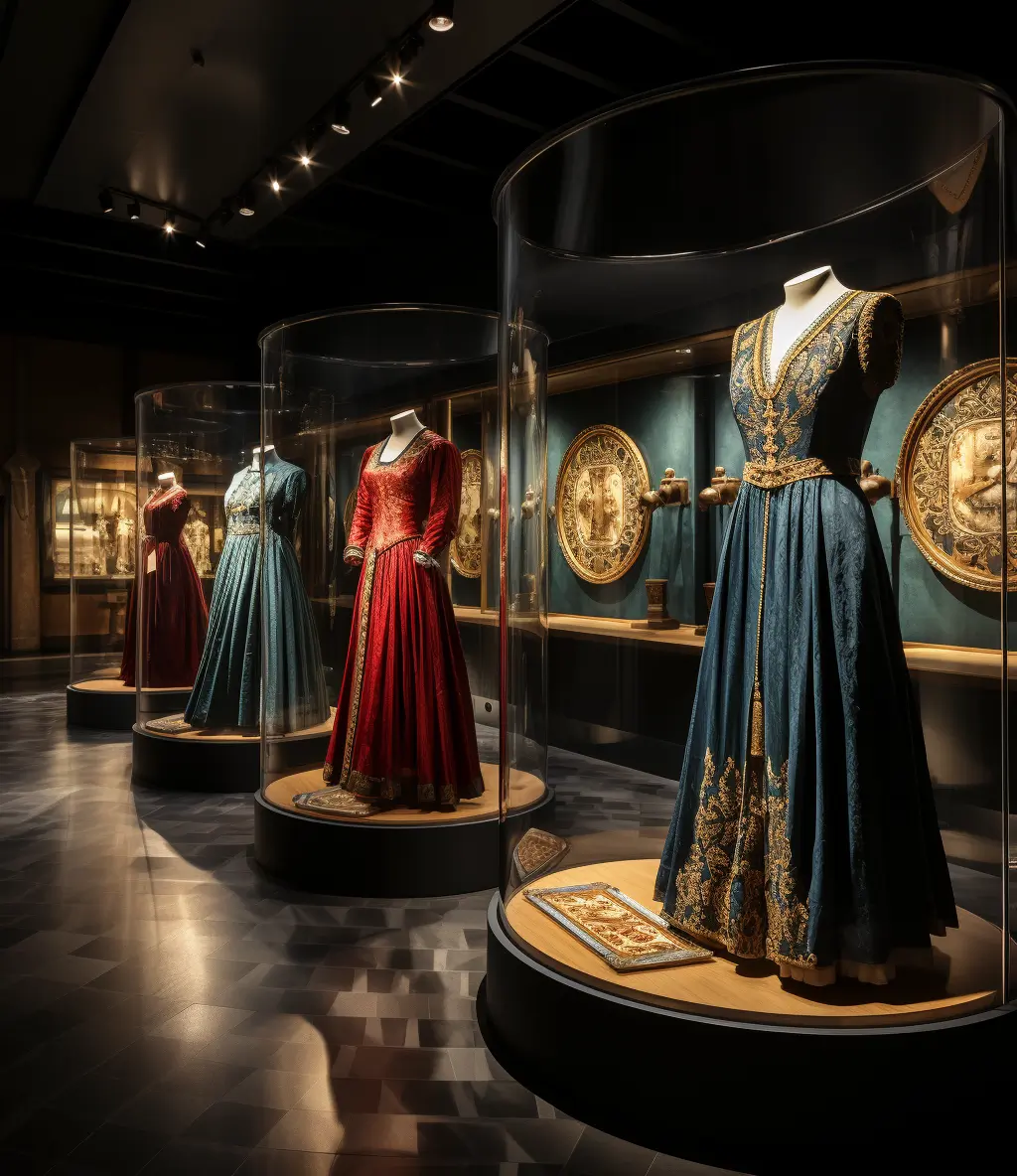



(Image: An illustration depicting a medieval royal procession, where kings and queens, adorned in regal attire, are accompanied by clergy, symbolizing the intertwining of religion and monarchy.)
- Ecclesiastical Symbols: Kings and queens often incorporated religious symbols into their attire, such as crosses and the lamb of God. This conveyed their divine right to rule and their close association with the Church.
- Ceremonial Attire: For religious ceremonies and important events, monarchs donned specialized garments, each with its own religious significance. These outfits were meant to showcase their piety and devotion.
Political and Societal Messages: Garments as Statements
In the complex tapestry of medieval politics and society, clothing played a pivotal role as a means of communication.
- Diplomacy Through Dress: Monarchs used clothing to convey political messages. When hosting foreign dignitaries, they often wore attire that featured the colors or emblems of the visiting nation, signifying goodwill and diplomacy.
- Societal Values: Changes in fashion often mirrored broader societal shifts. The rise or fall of certain styles could reflect evolving values, such as the transition from the opulence of the high medieval era to the more understated styles of the late medieval period.
As we unravel the cultural significance of medieval royal fashion, we unearth a treasure trove of insights into the dynamics of this era. The clothing of kings and queens, far from being mere costumes, was a dynamic language, speaking volumes about faith, politics, and the ever-changing tapestry of society.
Design and Craftsmanship: Artistry Woven in Threads
As we delve deeper into the intricacies of medieval royal fashion, we arrive at a realm where artistry and craftsmanship elevate clothing to a form of high art. The gowns and regalia of kings and queens were not mere garments; they were canvases on which master tailors and embroiderers painted stories of opulence and refinement.
Master Tailors and Embroiderers: The Artisans Behind the Attire
At the heart of royal fashion were the skilled craftsmen who transformed fabrics into works of art. These master tailors and embroiderers were the unsung heroes of regal attire.
(Placeholder for Image: A bustling medieval workshop filled with artisans meticulously crafting royal garments. Master tailors carefully measure fabrics, while embroiderers delicately weave intricate designs onto robes and gowns.)
- Art of Tailoring: Master tailors were responsible for creating impeccable fits and silhouettes for monarchs. Their understanding of fabrics and drapery allowed them to craft garments that enhanced the regal presence of kings and queens.
- Intricate Embroidery: Embroiderers worked tirelessly to add intricate patterns, symbols, and embellishments to royal attire. Gold and silver threads, as well as precious gemstones, were employed to create breathtaking designs.
Preservation of Royal Garments: A Legacy Honored
The preservation of medieval royal garments is a testament to their enduring significance. These garments, once worn by kings and queens, are now cherished relics that provide insights into the fashion of a bygone era.
Image: A museum exhibition showcasing the meticulous preservation of medieval royal garments. Gowns and robes, carefully encased in glass, stand as a testament to the artistry and craftsmanship of the past.)
- Museums and Exhibitions: Today, these historic garments are often showcased in museums and exhibitions. Such displays allow us to appreciate the intricate details and craftsmanship of medieval attire up close.
- Conservation Efforts: Preservationists work diligently to conserve these precious relics. They use specialized techniques to protect the fabrics, threads, and embellishments, ensuring that they can be admired by generations to come.
As we conclude our exploration of design and craftsmanship, we find ourselves in awe of the artisans who transformed cloth into regal attire. The artistry woven in every thread, the precision of tailoring, and the meticulous preservation of these garments all serve as a testament to the enduring legacy of medieval royal fashion.
Community Engagement: Connecting Threads of Enthusiasm
Now, my fellow enthusiasts of fashion history, we delve into a realm where the love for medieval royal fashion unites us all—the vibrant community that celebrates the past through the lens of clothing. In this section, we explore how fashion aficionados connect, share knowledge, and foster a collective appreciation for this timeless art.
Interacting with Fellow Enthusiasts: A Gathering of Minds
The internet has woven a global tapestry of fashion history enthusiasts, bringing together individuals who share a passion for the past. Online forums and communities have become digital courts where ideas and knowledge are exchanged.
(Placeholder for Image: An online fashion history community, featuring vibrant discussions, shared insights, and a sense of camaraderie among enthusiasts from around the world.)
- Knowledge Exchange: Enthusiasts engage in lively discussions, sharing insights on historical fashion trends, iconic garments, and the cultural significance of attire.
- Q&A Sessions: Experts often host Q&A sessions, where members can pose questions and seek guidance on various aspects of fashion history.
Virtual Exhibitions: Exploring the Past from Afar
In the digital age, the appreciation of medieval royal fashion has transcended physical boundaries. Virtual exhibitions have emerged as a means to explore and admire historical garments.

(Image: exhibition showcasing meticulously recreated medieval royal attire.)
- Online Displays: Curators and historians create virtual exhibitions, allowing enthusiasts to explore royal attire in exquisite detail, from the comfort of their screens.
- 360-Degree Views: Some virtual exhibitions offer 360-degree views of garments, enabling viewers to zoom in on embroidery, fabrics, and accessories.
As we conclude our exploration of the fashion history community, we recognize the invaluable role it plays in preserving and disseminating knowledge about medieval royal fashion. Through digital interactions and virtual exhibitions, enthusiasts unite in a shared love for the sartorial treasures of the past.
Reflecting on Medieval Majesty: A Journey Through Time
Our captivating journey through the annals of medieval royal fashion draws to a close, but the echoes of regal attire continue to reverberate. In this concluding section, we take a moment to reflect on the grand tapestry we’ve explored, and extend an invitation to continue this fascinating voyage through the ages.
A Tapestry Woven in Time
From the majestic gowns of kings and queens to the elegant attire of nobles and courtiers, we’ve unraveled the layers of opulence that defined medieval royal fashion. We’ve witnessed how garments were more than just fabrics—they were statements of power, faith, and artistry.
(Placeholder for Image: An image capturing a tapestry that depicts key moments in medieval royal fashion. The tapestry serves as a visual summary of our journey through the clothing and styles of the era.)
- Cultural Insights: We explored the cultural significance of attire, delving into how fashion intertwined with religion, politics, and societal values.
- Artistry and Craftsmanship: The artistry of master tailors and embroiderers, as well as the preservation of royal garments, showcased the timeless craftsmanship that continues to inspire.
Invitation to Continue the Journey
Our exploration of medieval royal fashion is but one thread in the vast tapestry of history. The allure of the past beckons us to delve deeper, to uncover more stories, and to celebrate the enduring influence of fashion.
- Further Adventures: There are countless eras and styles to explore in the world of fashion history. From the Renaissance to the Rococo, each period offers its own unique tales of sartorial splendor.
- Join the Conversation: The fashion history community eagerly welcomes new members. Engage in discussions, share your discoveries, and together, we can continue to unravel the mysteries of the past.
As we bid farewell to this journey, let us carry with us the appreciation for the intricacies of medieval royal fashion. The legacy of kings and queens lives on in the garments they once wore, and the stories they continue to tell.
This concludes our exploration of medieval royal fashion, a journey that has transported us through time and unveiled the majesty of the past. We invite you to continue your quest for sartorial knowledge and to share in the collective enthusiasm of fashion history enthusiasts around the world.



